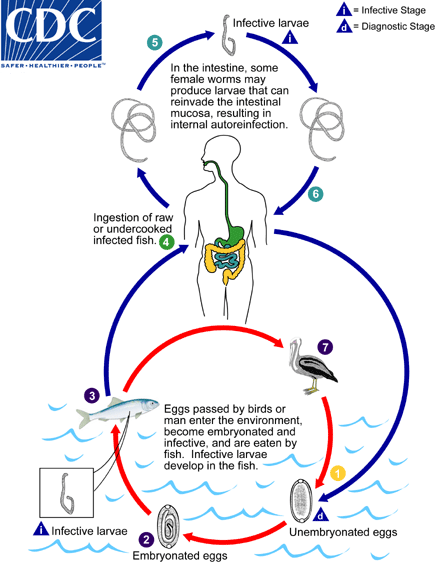Biology - Life Cycle of Capillaria philippinensis
Life Cycle:

Typically, unembryonated eggs are passed in the human stool ![]() and become embryonated in the external environment
and become embryonated in the external environment ![]() ; after ingestion by freshwater fish, larvae hatch, penetrate the intestine, and migrate to the tissues
; after ingestion by freshwater fish, larvae hatch, penetrate the intestine, and migrate to the tissues ![]() . Ingestion of raw or undercooked fish results in infection of the human host
. Ingestion of raw or undercooked fish results in infection of the human host ![]() . The adults of Capillaria philippinensis (males: 2.3 to 3.2 mm; females: 2.5 to 4.3 mm) reside in the human small intestine, where they burrow in the mucosa
. The adults of Capillaria philippinensis (males: 2.3 to 3.2 mm; females: 2.5 to 4.3 mm) reside in the human small intestine, where they burrow in the mucosa ![]() . The females deposit unembryonated eggs. Some of these become embryonated in the intestine, and release larvae that can cause autoinfection. This leads to hyperinfection (a massive number of adult worms)
. The females deposit unembryonated eggs. Some of these become embryonated in the intestine, and release larvae that can cause autoinfection. This leads to hyperinfection (a massive number of adult worms) ![]() . Capillaria philippinesis is currently considered a parasite of fish eating birds, which seem to be the natural definitive host
. Capillaria philippinesis is currently considered a parasite of fish eating birds, which seem to be the natural definitive host ![]() .
.
Life cycle image and information courtesy of DPDx.
- Page last reviewed: March 17, 2015
- Page last updated: March 17, 2015
- Content source:


 ShareCompartir
ShareCompartir